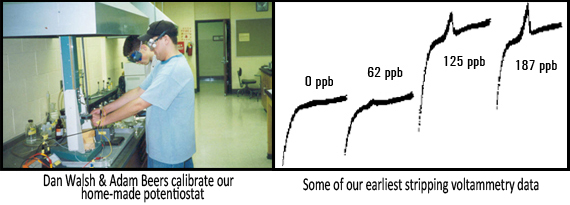The Center for Electroanalytical Studies
"We're Changing the World One Electron at a Time"...
Mission Statement
The Center for Electroanalytical Studies is dedicated to providing valuable research experience to undergraduate students by developing electrochemical methodologies that serve the region.
History of the Center for Electroanalytical Studies
The Center for Electroanalytical Studies began at Southwest Minnesota State University (SMSU) in August 1997. Home-made equipment was used to conduct our first experiments involving the polarography of copper, iron, and cadmium.
Our home-made equipment was modified so it could be used for stripping voltammetry of lead. This work was presented by the group at the 1998 Spring National Meeting of the American Chemical Society (ACS) held in Anaheim, CA.

We purchased our first commercial instrument using Minnesota Higher Education Preservation and Renewal (HEPR) funds allocated in 1999 and began a lead-testing outreach program with area secondary schools. This work resulted in a publication in the Journal of Chemical Education in 2004 and a presentation at Purdue University in 2006.
The group obtained a grant from the Minnesota Center for Teaching and Learning (CTL) in 2003. We purchased a more sophisticated instrument and began analyzing the electrochemical properties of herbicides. This research resulted in two publications in the Journal of Electroanalytical Chemistry.

Funding
Our electrochemistry research is currently supported by the Minnesota Center for Teaching and Learning (CTL), Southwest Minnesota State University (SMSU) Foundation, and the Faculty Improvement Grant (FIG) committee. Additional sources of fund are:
- Higher Education Asset Preservation and Renewal (HEAPR)
- American Recovery and Reinvestment Act (ARRA)
- National Science Foundation (NSF) – Grantee Robert Eliason
Contributions for additional funding are welcome. For more information of ways help support our research contact the SMSU Foundation to learn more about Ways to Give. Or, you may contact the SMSU Foundation at 1-800-260-0970 or foundation@smsu.edu. We are thankful for any support received.
Current Research Focus
To determine the electrochemical properties responsible for the biological activity of triazine herbicides. The purpose of the work is to determine structural changes to produce more effective herbicides. Projects include:
- Differential pulse voltammetry of simazine and cyanazine.
- Computer modeling of the triazine herbicide reduction process.
- The study of herbicide adsorption on the electrode surface.
- Extraction and analysis of herbicide metabolites from plant materials.
Student Presentations
Undergraduate Research Poster Sessions (URPS) held during various spring national meetings of the American Chemical Society (ACS) 2006-present.
- Soua Vue, Electrochemical trace analysis of cyanazine, San Diego, 2012.
- Angela Reimers, Electrochemistry of atrazine: Experimental evidence for a 2-electron reduction intermediate, Anaheim, 2011.
- Robin Hull, Preferred forms of hydroxypropazine, San Francisco, 2010.
- Thomas Kosgei, Stripping voltammetry of arsenic, Salt Lake City, 2009.
- Matthew Bruzek, Voltammetry of propazine, New Orleans, 2008.
- Paul DeVos, Voltammetry of atrazine, Chicago, 2007.
- Kyle Henning, Voltammetry of simazine, Chicago, 2007.
- Nathan Morris, Arsenic testing using anodic stripping voltammetry, Chicago, 2007.
- Joshua Ochocki, Voltammetry of cyanazine, Atlanta, 2006.
Publications
- Bruzek, M. J. ‡, Henderson, J. K. ‡, Hull, R. L. ‡;, Becht, S. B. ‡, Brown, J. H. Electrochemical reduction of propazine: NMR evidence for dechlorination and reduction of the triazine ring. J. Electroanal. Chem., 2010, 642, 13-16.
- Guse, D. ‡; Bruzek, M. J. ‡; DeVos, P. ‡; Brown, J. H. Electrochemical reduction of atrazine: NMR evidence for reduction of the triazine ring. J. Electroanal. Chem., 2009, 626, 171-173.
- Louwagie A. ‡; Ludbohm, L. ‡; Goebel, A. ‡; Vos, T. ‡; Brown, J. H. Lead-testing in Area Secondary Schools Using Anodic Stripping Voltammetry. J. Chem. Ed., 2004, 81, 214-217.
‡Indicates SMSU research student.
Interested In Electrochemistry Research?
Become a member of our group. Projects start at the beginning of fall semester and last 1-2 years. Prerequisites include the General Chemistry and Organic Chemistry I/II sequences. Contact Jay Brown for details.
Contact Information
Science Department, Chemistry
SM 178
Southwest Minnesota State University
1501 State Street * Marshall, MN 56258
Ph: (507) 537-6178 * Fax: (507) 537-6151
Dr. Jay Brown, Professor of Chemistry
Office: SM 232
Ph: (507) 537-6558, jay.brown@smsu.edu
Last Modified: 6/8/22 5:17 PM | Website Feedback


